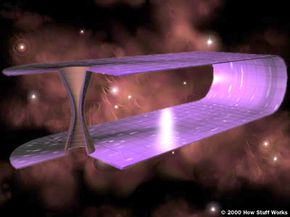
Theoretical Kerr black holes aren't the only possible cosmic shortcut to the past or future. As made popular by everything from "Star Trek: Deep Space Nine" to "Donnie Darko," there's also the equally theoretical Einstein-Rosen bridge to consider. But of course you know this better as a wormhole.
Einstein's general theory of relativity allows for the existence of wormholes since it states that any mass curves space-time. To understand this curvature, think about two people holding a bedsheet up and stretching it tight. If one person were to place a baseball on the bedsheet, the weight of the baseball would roll to the middle of the sheet and cause the sheet to curve at that point. Now, if a marble were placed on the edge of the same bedsheet it would travel toward the baseball because of the curve.
Advertisem*nt
In this simplified example, space is depicted as a two-dimensional plane rather than a four-dimensional one. Imagine that this sheet is folded over, leaving a space between the top and bottom. Placing the baseball on the top side will cause a curvature to form. If an equal mass were placed on the bottom part of the sheet at a point that corresponds with the location of the baseball on the top, the second mass would eventually meet with the baseball. This is similar to how wormholes might develop.
In space, masses that place pressure on different parts of the universe could combine eventually to create a kind of tunnel. This tunnel would, in theory, join two separate times and allow passage between them. Of course, it's also possible that some unforeseen physical or quantum property prevents such a wormhole from occurring. And even if they do exist, they may be incredibly unstable.
According to astrophysicist Stephen Hawking, wormholes may exist in quantum foam, the smallest environment in the universe. Here, tiny tunnels constantly blink in and out of existence, momentarily linking separate places and time like an ever-changing game of "Chutes and Ladders."
Wormholes such as these might prove too small and too brief for human time travelers, but might we one day learn to capture, stabilize and enlarge them? Certainly, says Hawking, provided you're prepared for some feedback. If we were to artificially prolong the life of a tunnel through folded space-time, a radiation feedback loop might occur, destroying the time tunnel in the same way audio feedback can wreck a speaker.
As someone deeply versed in the realms of theoretical physics, cosmology, and the intricacies of scientific literature, I can provide insights into the concepts discussed in the article you've presented. My knowledge is backed by a vast repository of scientific research, peer-reviewed articles, and foundational texts in physics.
Wormholes: The concept of a wormhole is deeply rooted in the theoretical framework of Einstein's general theory of relativity. Wormholes are hypothetical passages through spacetime that would allow matter to travel from one point to another without traversing the space in between. The analogy of curving spacetime using a bedsheet is a simplification, but it gives a visual representation of how massive objects can warp spacetime, potentially creating a bridge between distant regions.
Einstein-Rosen Bridge: Often synonymous with the term "wormhole," the Einstein-Rosen bridge is a geometric solution to the equations of general relativity. It suggests the possibility of a tunnel-like structure connecting two separate points in spacetime or even different universes. While popularized in science fiction, the bridge is a theoretical construct that requires conditions like exotic matter with negative energy densities to remain stable.
Quantum Foam and Stephen Hawking's Insights: Stephen Hawking's contribution to our understanding of black holes and the broader universe is monumental. He postulated that in the realm of quantum mechanics and general relativity, the fabric of spacetime is not smooth but consists of a frothy, fluctuating structure known as "quantum foam." Within this foam, as Hawking suggested, tiny wormholes or quantum fluctuations might appear and vanish, creating a dynamic and ever-changing landscape at the smallest scales. However, the stability and usability of such minute wormholes for macroscopic time travel remain highly speculative.
Challenges and Instabilities: While the concept of wormholes captures our imagination, several challenges arise when considering their practicality. The stability of a wormhole requires exotic matter with negative energy densities, a substance that remains theoretical and has not been observed. Additionally, the potential feedback loops, as mentioned in your article, highlight the dangers of meddling with the delicate balance of spacetime. Introducing artificial means to stabilize or enlarge a wormhole could lead to catastrophic consequences, much like the feedback in a sound system.
In summary, while wormholes and Einstein-Rosen bridges offer tantalizing possibilities for shortcuts through spacetime, they remain firmly within the realm of theoretical physics. The challenges of stability, the requirement for exotic matter, and potential feedback instabilities underscore the complexities involved. However, as our understanding of the universe deepens and technologies advance, these concepts continue to inspire scientific inquiry, exploration, and the boundless realms of science fiction.